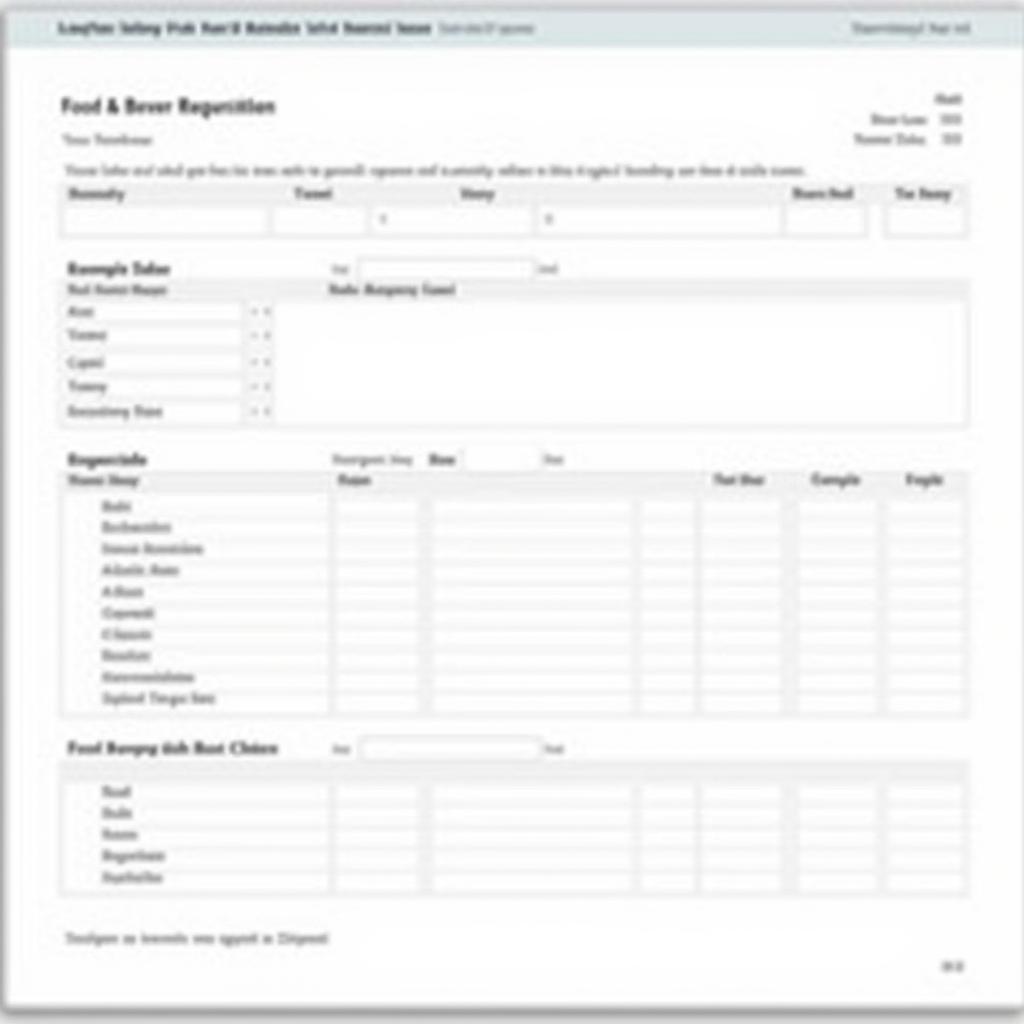A well-managed food and beverage operation hinges on efficient inventory control. At the heart of this control lies the Food And Beverage Requisition Form, a vital document that ensures smooth operations and minimizes waste. This guide will delve into the intricacies of the food and beverage requisition form, exploring its importance, components, best practices, and how it contributes to a thriving food and beverage business.
What is a Food and Beverage Requisition Form?
A food and beverage requisition form is a standardized document used to request items from a storage area or department. It acts as a formal request, ensuring accurate inventory tracking and preventing unauthorized withdrawals. This form plays a crucial role in maintaining optimal stock levels, minimizing spoilage, and controlling costs. It also serves as a communication tool between different departments, ensuring everyone is on the same page.
Key Components of a Food and Beverage Requisition Form
A well-designed food and beverage requisition form should include the following key elements:
- Requisition Number: A unique identifier for each request, facilitating tracking and record-keeping.
- Date: The date the requisition was submitted.
- Requesting Department: Identifies the department or kitchen making the request.
- Delivery Date: Specifies the desired delivery date and time.
- Item Description: A clear and concise description of each item requested.
- Quantity Required: The precise amount of each item needed.
- Unit of Measure: Specifies the unit (e.g., pounds, kilograms, cases).
- Authorized Signature: Signature of the authorized personnel approving the request.
Best Practices for Using Food and Beverage Requisition Forms
Implementing effective practices for using these forms is crucial for maximizing their benefits. Here are some key recommendations:
- Standardize the Form: Use a consistent format across all departments to minimize confusion.
- Train Staff: Ensure all staff members understand how to complete and submit the form correctly.
- Regularly Review and Update: Keep the form updated with current inventory items and prices.
- Electronic Forms: Consider using electronic requisition forms for increased efficiency and accuracy.
- Integrate with Inventory Management System: Seamless integration streamlines the process and reduces manual data entry.
 Example of a Food and Beverage Requisition Form
Example of a Food and Beverage Requisition Form
Benefits of Using a Food and Beverage Requisition Form
Implementing a standardized food and beverage requisition form offers numerous advantages:
- Improved Inventory Control: Accurate tracking of inventory levels minimizes waste and prevents shortages.
- Cost Savings: Reduces over-ordering and spoilage, leading to significant cost savings.
- Streamlined Operations: Facilitates efficient communication between departments and ensures timely delivery of supplies.
- Enhanced Accountability: Provides a clear audit trail for all inventory transactions.
- Better Budgeting and Forecasting: Accurate data helps in better budget planning and forecasting future needs.
Common Scenarios and FAQs about Food and Beverage Requisition Forms
- What happens if an item is out of stock? The storage department should notify the requesting department and offer a suitable substitute or suggest a revised delivery date.
- Who is responsible for approving requisition forms? Typically, a designated manager or supervisor is responsible for approving requests.
- Can requisition forms be submitted electronically? Yes, many establishments utilize electronic systems for faster processing and reduced paperwork.
Food and Beverage Requisition Form: A Cornerstone of Efficient Operations
Effective inventory management is the backbone of any successful food and beverage business. The food and beverage requisition form, though seemingly simple, plays a vital role in this process. By understanding its importance, implementing best practices, and utilizing technology, businesses can optimize their operations, minimize waste, and maximize profitability.
“A well-designed requisition process is like a well-oiled machine, ensuring every ingredient is in its right place at the right time,” says renowned chef and restaurant consultant, Anthony Bourdain Jr.
 Efficient Restaurant Kitchen Inventory Management
Efficient Restaurant Kitchen Inventory Management
Conclusion
The food and beverage requisition form is more than just a piece of paper; it’s a crucial tool for managing resources, controlling costs, and ensuring the smooth operation of any food and beverage establishment. Mastering its use is essential for achieving success in this competitive industry. By adopting the best practices outlined in this guide, businesses can optimize their inventory management and unlock significant benefits.
FAQs
- What is the primary purpose of a food and beverage requisition form? To formally request items from storage, ensuring accurate inventory control.
- Who typically initiates a food and beverage requisition form? The department or kitchen needing the supplies.
- What information is essential on a food and beverage requisition form? Item description, quantity, unit of measure, requesting department, and authorization signature.
- How can electronic requisition forms benefit a business? Increased efficiency, reduced paperwork, and improved accuracy.
- Why is proper training on using requisition forms important? To ensure consistent and accurate use, maximizing the form’s benefits.
- How do requisition forms contribute to cost savings? By preventing over-ordering and minimizing spoilage.
- What is the connection between requisition forms and budgeting? Accurate data from requisition forms aids in better budget planning and forecasting.
Other related articles you might find helpful:
- Inventory Management Best Practices for Restaurants
- Reducing Food Waste in Your Food Business
- The Importance of Standardized Procedures in Food Service
Need assistance? Contact us at Phone Number: 02437655121, Email: minacones@gmail.com Or visit our address: 3PGH+8R9, ĐT70A, thôn Trung, Bắc Từ Liêm, Hà Nội, Việt Nam. We have a 24/7 customer support team.